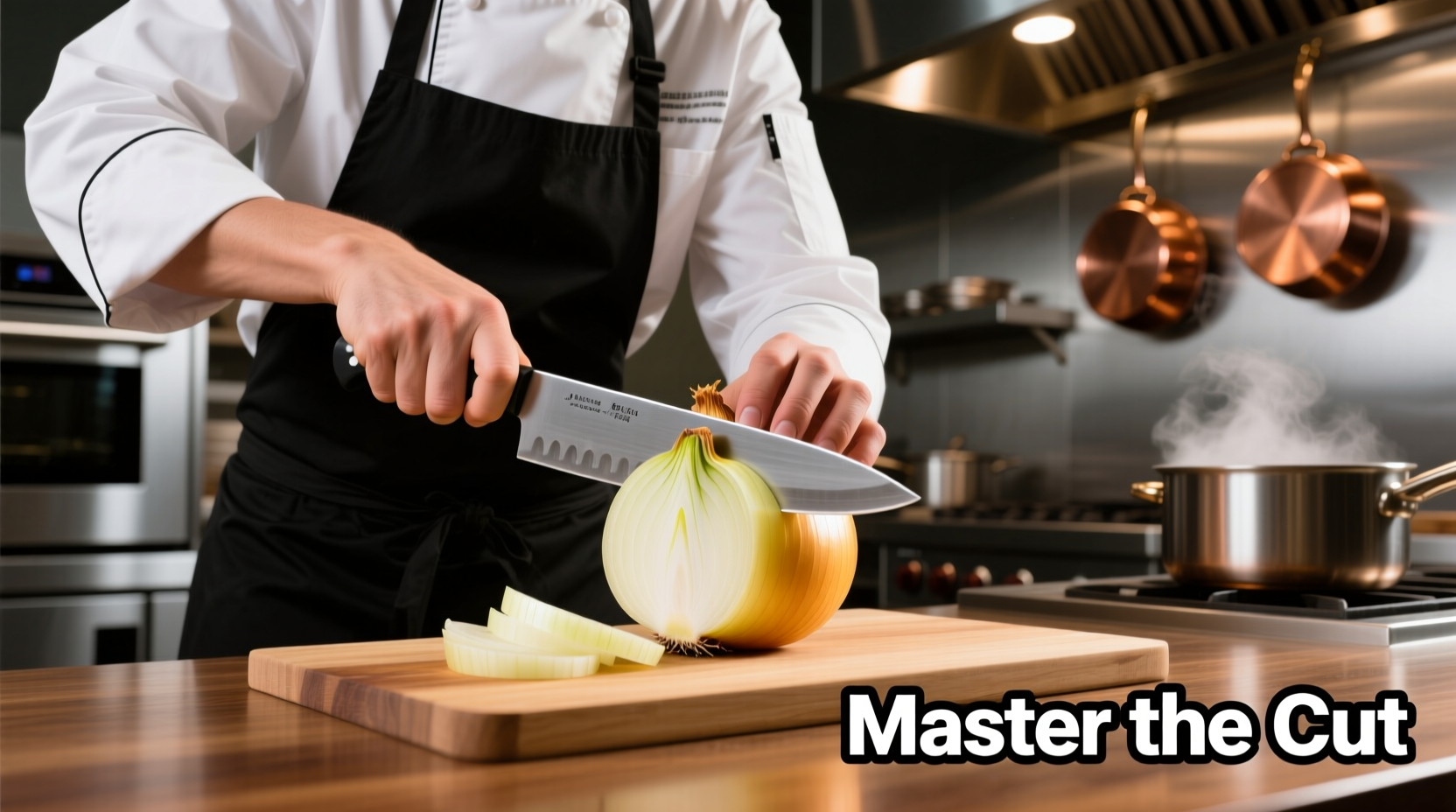Master the perfect onion cut in minutes with professional techniques that prevent tears, ensure even cooking, and maximize flavor. This guide reveals the exact methods top chefs use for consistent results every time—no special equipment required.
Ever wonder why your stir-fries have unevenly cooked onions while restaurant dishes feature perfectly uniform pieces? The secret lies in proper onion cutting technique. As a professional chef with years of experience in Michelin-starred kitchens, I've discovered that how you cut an onion affects flavor release, cooking time, and final dish texture more than most home cooks realize. Whether you're preparing a French onion soup or a quick weeknight stir-fry, the right cut makes all the difference.
The Science Behind Onion Cutting
When you cut an onion, you rupture cells containing enzymes and sulfur compounds. These react to form syn-propanethial-S-oxide—the chemical responsible for that familiar eye irritation. According to the American Chemical Society, chilling onions before cutting slows this reaction, reducing tears by up to 60%. Proper knife technique also minimizes cell damage, controlling both flavor release and tear production.
Essential Tools for Perfect Onion Cutting
You don't need expensive equipment, but the right tools make a significant difference:
- Sharp chef's knife (8-inch): A sharp blade slices cleanly through cells rather than crushing them
- Stable cutting board: Wood or soft plastic prevents slipping and protects your knife edge
- Bowl of ice water: For chilling onions before cutting (reduces tears)

Step-by-Step: The Professional Onion Dice
Follow these steps for restaurant-quality diced onions every time:
- Prep the onion: Cut 1/4 inch off the root end (keep intact for stability), then slice off the stem end
- Peel and halve: Remove skin, then cut vertically through the root end
- Create guide cuts: Make horizontal slices toward (but not through) the root end
- Vertical slices: Cut vertically from stem to root, creating even strips
- Final dice: Slice across strips for perfect uniform pieces
This technique preserves the root structure until the final cut, providing stability and preventing uneven pieces. For how to cut an onion without crying, chill the onion for 30 minutes before cutting and keep the root end intact as long as possible.
When to Use Which Onion Cut
Not all recipes require the same cut. Using the wrong technique can ruin your dish. Here's when to use each method:
| Cut Type | Best For | Avoid In | Cutting Time |
|---|---|---|---|
| Small Dice (1/8") | Salsas, mirepoix, sauces | Grilled dishes, salads | 3-4 minutes |
| Medium Dice (1/4") | Stir-fries, soups, stews | Fine sauces, garnishes | 2-3 minutes |
| Large Dice (1/2") | Ratatouille, kebabs, roasting | Quick-cooking dishes | 1-2 minutes |
| Thin Slices | Caramelizing, French onion soup | Long-cooking stews | 2-3 minutes |
This onion cutting techniques comparison shows why matching your cut to the cooking method matters. For example, small dice works best in salsas because the increased surface area releases more flavor quickly, while large dice holds its shape during roasting.
Advanced Cutting Methods for Specific Dishes
Professional kitchens use specialized cuts for particular applications:
The Julienne Cut for Salads
For crisp salads where you want visible onion strips without overpowering flavor:
- Cut onion in half vertically
- Make thin parallel slices perpendicular to the root end
- Soak in ice water for 10 minutes to crisp and reduce sharpness
The French "Émincer" for Caramelizing
For perfect caramelized onions with even browning:
- Cut onion in half vertically
- Slice paper-thin across the grain
- Use a mandoline for consistent 1/16" thickness
According to FDA food safety guidelines, properly cut onions should be refrigerated within two hours and stored in airtight containers. Smaller cuts degrade faster—use diced onions within 2 days while larger cuts last up to 5 days.
Troubleshooting Common Onion Cutting Problems
Problem: Uneven pieces
Solution: Maintain consistent pressure and angle with your knife. Practice the "claw grip" with your non-knife hand to control thickness.
Problem: Mushy onions
Solution: Use a sharp knife and avoid excessive handling. Dull knives crush cells, releasing more moisture.
Problem: Excessive tearing
Solution: Chill onions before cutting, use a sharp knife, and cut near running water or under a vent. For how to cut onions without crying naturally, try breathing through your mouth while cutting.
Perfecting Your Onion Cutting Technique
Like any culinary skill, perfect onion cutting requires practice. Start with one technique (the medium dice is most versatile) and master it before moving to others. Remember that proper onion cutting technique for cooking affects more than just appearance—it controls flavor distribution, cooking time, and final dish texture.
Professional chefs develop muscle memory through repetition. Dedicate 5 minutes of your next three cooking sessions to practicing your onion cuts, and you'll notice significant improvement. The difference between amateur and professional cooking often comes down to these fundamental techniques.











 浙公网安备
33010002000092号
浙公网安备
33010002000092号 浙B2-20120091-4
浙B2-20120091-4